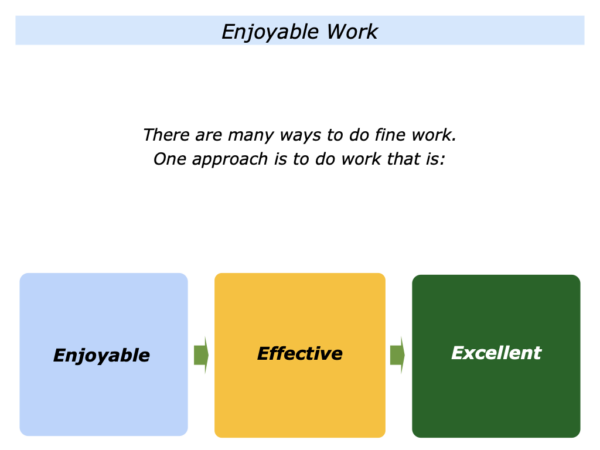
There are many ways to do fine work. One approach is to do work that is enjoyable, effective and excellent. Sometimes it may also involve going into another dimension and doing work that is extraordinary.
Imagine that you want to follow elements of this approach. This can involve doing work that focuses on the following themes.
Enjoyable Work
What are the kinds of work you enjoy doing? What are those where you enjoy the journey as well as reaching the goal? What are those you may be able to encourage other people? What are those where you may be able to deliver excellence?
Some individuals do their best work where they feel in their element – at ease and yet able to excel. They feel confident and in control. They say to themselves:
“This is where I was meant to be.”
They have the strengths and skills to deliver success. They feel at ease in situations that others may find difficult. They may enjoy tackling certain challenges, managing crises, performing on stage, competing in sports or doing other activities.
They love to stretch themselves, feel alive and, in some cases, get an adrenaline rush. They then apply their abilities to work towards achieving their goals.
What are the activities where you enjoy the journey – even though parts of it may be exhausting? Here are some answers that people give when exploring this theme.
The specific activities where I enjoy the
journey as well as reaching the goal are:
Helping people to overcome setbacks … Restoring houses … Solving certain technical problems … Passing on knowledge to people … Helping people to find or create satisfying careers.
Being a trusted advisor to clients … Working to build a fairer society … Producing solutions focused journalism … Orchestrating people to achieve a compelling goal.
Many people feel alive when doing stimulating work. Some people stop doing this and feel clogged up. Sometimes they can regain their zest for life by refocusing on the kinds of work they find stimulating.
Let’s return to your own life and work. What is a specific activity where you enjoy the journey as well as reaching the goal? What are the reasons why you enjoy this activity? What are the specific things you can do to pursue this activity in the future?
Effective Work
Great workers believe in doing work that is effective. When doing a particular project or tackling a challenge, they focus on what works. Some may also aim to do work that encourages people. They aim to build on their strengths, follow strategies that work and deliver success.
They may work as a teacher, medical worker, sports coach or crisis manager. They may work as a scientist, specialist, leader, trusted advisor or in another professional role.
They may aim to create beautiful things, write inspiring articles or raise money for charity. They may run a social enterprise, improve people’s quality of life, pass on practical knowledge or do another activity.
Imagine that you want to do work that is effective. One approach is to start by exploring the following themes.
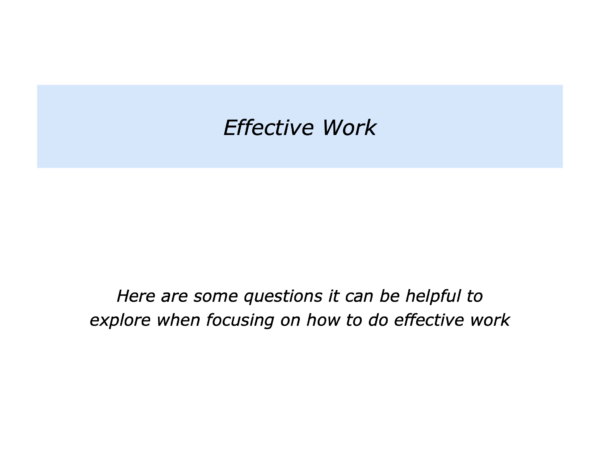
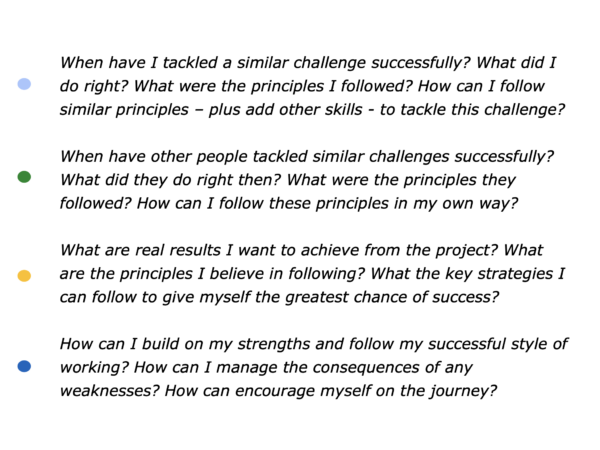
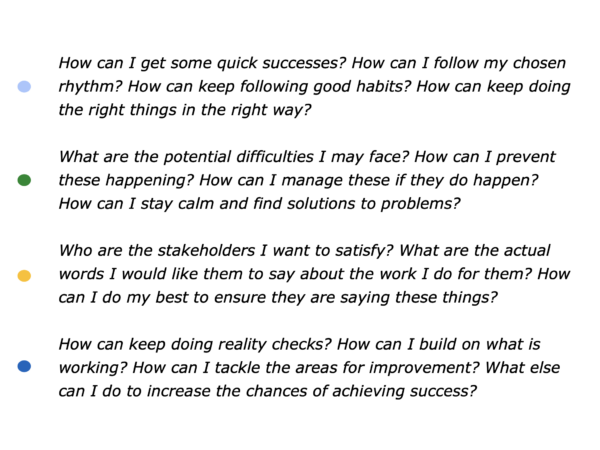
Different people follow this approach in different ways. As mentioned, some aim to do work that encourages people. Let’s look at one such approach.
Maggie’s Centres aim to empower people to live with, through and beyond cancer. The following section includes excerpts from the organisation’s website and images from some of their many centres.
Maggie Keswick Jencks was the co-founder, alongside Charles Jencks, of Maggie’s Cancer Caring Centres. Maggie was a writer, a landscape designer, a painter and a mother of two.
In May 1993, Maggie was told that her breast cancer had recurred and spread to her bones, liver and brain. When asked, her Dumfries oncologist gave her two to three months to live.
By joining a trial involving advanced chemotherapy Maggie extended her life by a further 18 months and it was in this time that her idea for a cancer caring centre was born.
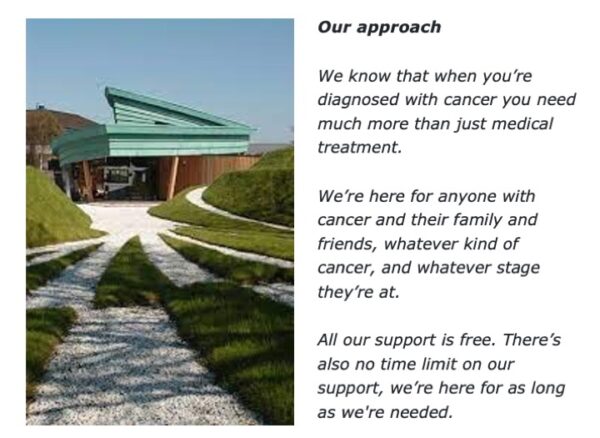
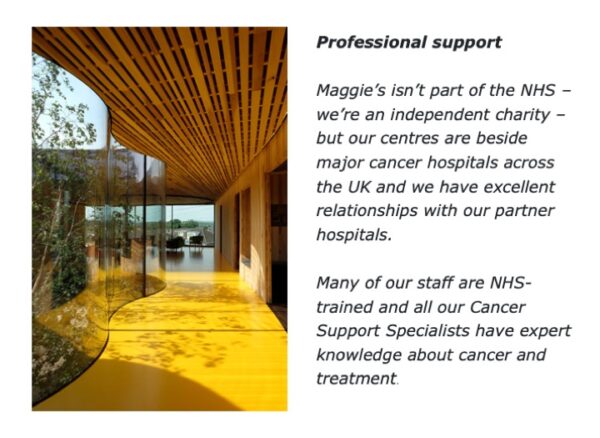
She worked closely with Laura Lee, her oncology nurse, and was asked to write an article for a medical journal on a patient’s perspective on being treated for cancer.
Maggie was convinced that everybody would feel better if they felt able to take some active role in what was happening to them.
She talked to her medical team at the Western General Hospital in Edinburgh about a place to help their patients with the very real, if not medical, problems of living with cancer.
She drew up a blueprint for a pioneering venture, in a stable block in the grounds of the hospital. Maggie died in July 1995. The first Maggie’s Centre opened in Edinburgh in November 1996.
Charles Jencks was a renowned cultural theorist, landscape designer, and architectural historian. “The Architecture of Hope” was co-authored by Charles with journalist and author, Edwin Heathcote. It explores the history of Maggie’s and the architectural tradition to which our centres and their gardens belong.
After Maggie’s diagnosis in 1993 Charles not only supported her through her treatment but also in her idea of better spaces for people with cancer.
He encouraged Maggie to set up the very first centre that bears her name and after her death continued to champion the huge importance of environment in helping people with cancer and their families.
Charles helped to create beautiful buildings that contribute to the significant work done at Maggie’s.
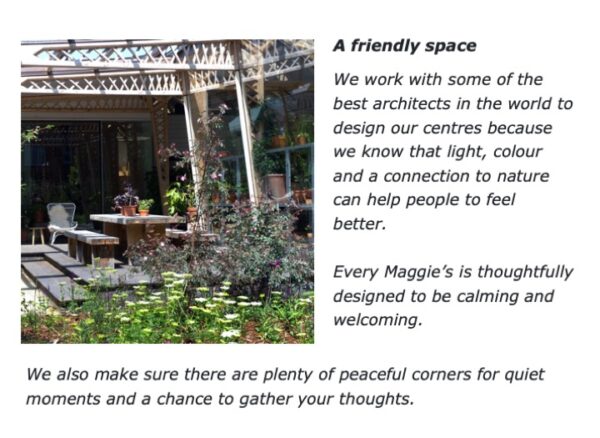
Looking back, can you think of a specific situation when you did enjoyable work that was also effective? What did you do right then? How can you follow these principles in the future?
Excellent Work
Imagine that you aim to do enjoyable work that is effective. You can then take the next step and aim to deliver excellence. Sometimes it can also lead to doing something extraordinary. Let’s explore how you can take these steps.
Being Effective Creates The
Platform For Delivering Excellence
There are many models for doing fine work. One approach is to do effective work to get to 7+/10. It is then to do something extra to get to 10/10.
Great workers often apply this approach. They aim to follow effective strategies and build a solid platform. They then, when appropriate, do something special to achieve excellence.
Doing work you enjoy is not always plain sailing. Sometimes it can involve tackling difficult challenges. It is then important to remind yourself of why you are doing the work.
Sometimes it can be useful to focus on the pleasure of doing such work – even in so-called pressure situations. It is important to retain your sense of joy because otherwise things can go awry. One athlete explained this in the following way.
“I had to rediscover my love for the sport. I had become caught up with the whirlwind of chasing money and comparing myself to others. This led to negative self-talk and frustration.”
Thomas Bjørn described a similar experience in the book he wrote with Michael Calvin called Mind Game: The Secrets of Golf’s Winners. In it he recalls learning how to deal with the demons in his own head.
This involved returning to the love he had for the game as a child. Here is an extract from the book where he describes facing this challenge.
“A light went out when I lost my swing for a couple of years. I look for myself today and realise I don’t play the game with the same love I lavished on it as a kid.
“I don’t run to practise or play golf for fun with my friends. To me, it is a job, and it is therefore a short-lived thing.”
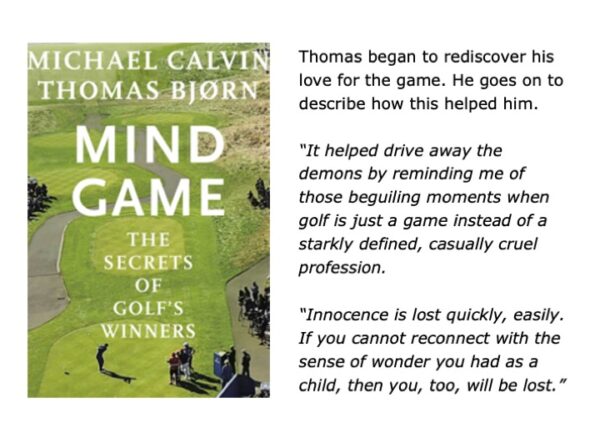
Another athlete aimed to do their personal best but not at any cost. They expressed their philosophy in the following way.
“I began playing sports for pleasure. I loved feeling alive and doing my best. My talent took me to the point where playing sport became a career. People then told me that I would need to sacrifice myself and even suffer if I was to reach the top.
“Looking at the people who had won titles, some said that it bought relief rather than joy. Some even lost things that were important in life – such as their marriages and contact with their children.
“I continue to get pleasure from my sport and make a good living. The most crucial thing, however, is that I have managed to focus on what I believe to be the most important things in life.”
The Entertainment Approach
Some people use their talents to focus on providing entertainment. This sounds far removed from doing effective work but the people who take this route often start by mastering the basics.
There are many definitions for the word entertainment. Here is one that covers some activities in the arts, music, sports and other fields.
Entertainment consists of performances that give people pleasure.
Different kinds of performers will have different views on the nature of their work. Much depends on their philosophy and the principles they aim to follow.
Some football managers, for example, say they are only interested in the business of winning. Some great football managers – such as Matt Busby, Bobby Robson and others – also saw it as their job as to provide entertainment.
Justin Hayward, a lead singer in the Moody Blues, said that the band saw it as important to entertain the fans who attended their concerts. The Moodies continued to evolve by doing experimental work in the studio and on their albums.
The band had a certain philosophy when it came to live shows, however, and focused on its audience. Here is a summary of how Justin described this approach.
“Many fans have followed us for decades. They may be interested in some of our new work but they really want to hear the songs that give them pleasure. We aim to honour this and give them a great experience.”
Excellent Work
Great workers aim to become the best they can be. They aim to deliver consistently high standards and produce excellence.
David Hemery, an Olympic Gold Medal winner, described the importance of athletes taking this approach in his 1991 book Sporting Excellence. Here is the official description of the book.
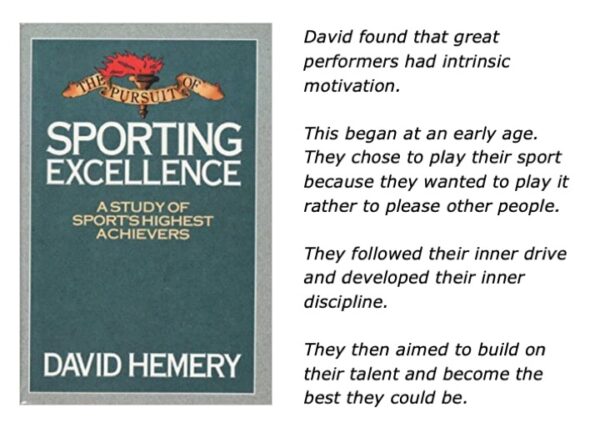
In his survey of over 50 world-class performers, David Hemery examines the common factors which separate the highest performers from the rest of the competition.
He asks over 80 questions covering subjects such as childhood, upbringing, parental guidance, coaching, personal relationships, destiny, stress and the influences of the mind.
Over the course of the study covering the performers’ physical, social, mental and moral development, various patterns emerged and these are illustrated with direct quotes taken from interviews given by the performers.
David aimed to spread this approach with his work in education, sports and business. His work includes creating a programme for schools which encourages young people to do their personal best.
The programme reached thousands of youngsters. It encouraged them to use their talents in the arts, sports, dance, maths, engineering, leadership and many other activities. David explained this approach in the following way.
Be The Best You Can Be!
Tens of thousands of young people from many backgrounds, ranging from the deprived to the privileged, are currently engaged in the Be The Best You Can Be! Programme across the UK.
All are enabled to follow their own unique learning journey to achieve their full intellectual, physical, social and spiritual potential as responsible individuals, citizens and member of their community.
There is a spark of greatness, something special and unique in everyone and Be The Best You Can Be! is designed to unlock more of each individual’s untapped potential and is the translation of inspiration into action.
Great organisations create an environment in which people are encouraged to do their best. This sometimes involves taking the next step.
Building An Excellence Culture
Rather Than An Excuse Culture
When have you encountered an excellence culture rather than an excuse culture? You may have visited a sports team, hospital, company or other organisation where people continually delivered high standards.
What did people do to create such a culture? How did they keep reminding people of what good looked like? How did they deal with any quality problems? Let’s explore how it is possible to make this happen.
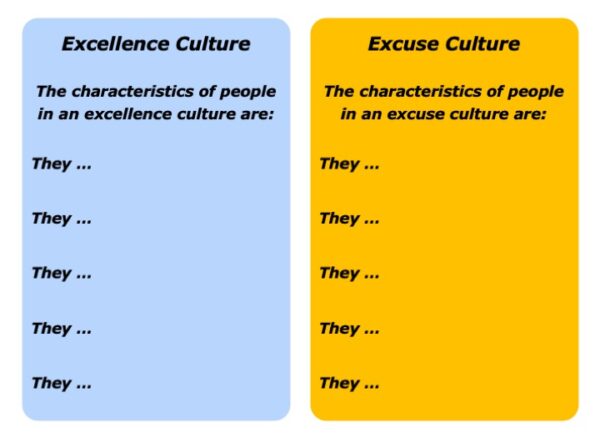
Many years ago I encountered two extreme cultures during the course of a week. The first culture exuded excellence.
The pathway to the building was clean and attractive. The reception people had been told I was arriving and had a badge ready. They provided coffee and fruit for visitors in the reception area where customer success stories were displayed on the walls.
Watching the employees arrive, they appeared friendly and wanting to work. The whole environment buzzed with a sense of energy. People took responsibility for maintaining the high standards.
The Chief Executive came to collect me rather than sending somebody else. Building on my comments about the reception area, she explained the company wanted the visitors to go away saying:
“That is the best reception area I have ever visited. It exemplified what the company aims to do each day. I wish my company’s reception area could be like that.”
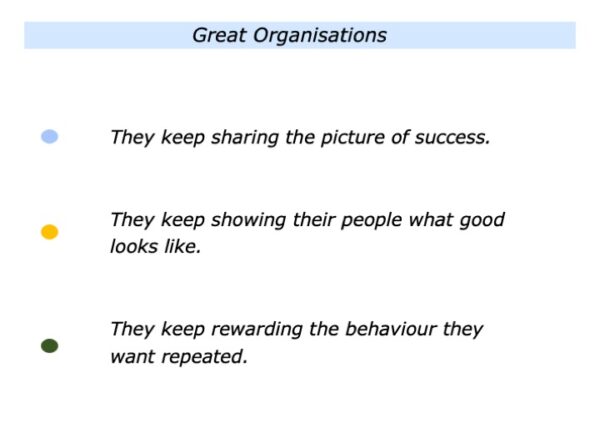
The second company I visited was much less inspiring. The grounds outside the main entrance were littered with cigarette butts, chewing gum and empty cans in the hedges.
The reception area was grubby and staffed by uninterested people from a security company. The meeting rooms were dark, had faulty window blinds and had packages stacked in the corners.
The company was grey. There were few signs of energy or love for the work. People failed to take responsibility for improving the standards. I left wondering how people got through each day.
Looking at your own experience, what do you think are the characteristics of an excellence culture? What are the values that people believe in? How do people translate these values into action? How do they actually behave?
Looking at the other extreme, what do you think are the characteristics of an excuse culture? How do people behave in such a culture? What happens as a result?
Good leaders reward the behaviour they want repeated. They also never walk past a quality problem – otherwise they have said it is okay.
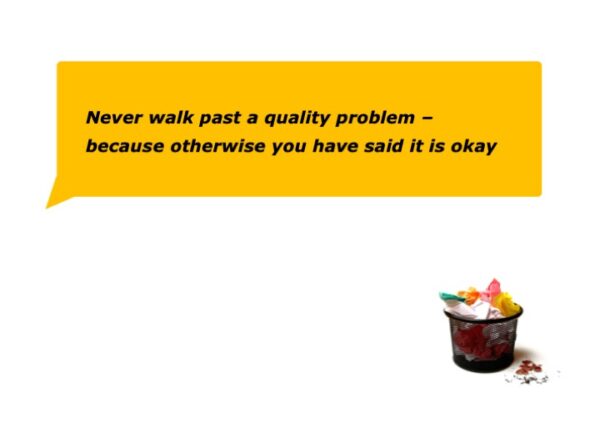
A Managing Director taught me about this when I was due to meet him. Sitting in the reception area of his company’s offices, I saw him park his car and begin walking toward the main entrance.
Suddenly he dived into the hedge and emerged with an empty drinks can. It was 7.30 in the morning and the can had obviously been thrown from the nearby main street during the night.
The MD explained his approach in the following way.
“I refuse to walk past a quality problem. If we don’t keep our hedges and car parks clean, visitors will think we don’t pay attention to our products.”
This approach also applies to dealing with people who display poor professional standards. Here is one example.
Imagine the scene. It is 9.30 on a Monday morning and one team member arrives 30 minutes late for a 9.00 meeting at the office. He then says the following things to the rest of the staff.
“What a terrible day. The trains are late and later I am due to meet the client from hell. What a way to begin Monday.”
What to do about such an entrance? You can ignore the person, confront them or adopt some other approach.
I witnessed such an incident when the leader asked the team member who arrived late to leave the room. He said:
“I wonder if you can replay that situation. Everybody has found it hard to get into work today, but we want to get on with the job.
“I would like you to go out, then come in again. This time, think about the impression you are giving to people in the office.
“I don’t want you to come in with a forced smile, but I do want you to think about the tone you are setting on a Monday morning. Do you want to try it? It’s up to you.”
That approach sounds heavy, but it actually worked. The team member smiled wryly, accepted the message and said:
“Sorry.”
They left the room and came in again 30 seconds later with a totally different attitude. The leader was not looking for clones, far from it, but he did want people who behaved professionally.
You will have your own way of never walking past a quality problem. This can be easy when it applies to physical products or customer service. But it can be harder with human behaviour.
People must get the message that certain actions are encouraged, however, whilst others are unacceptable. Corporate misdemeanours can often be traced back to ignoring people who behaved badly.
Good organisations encourage the people who take responsibility and deliver the required professional standards. They do not dilute their principles for those who do not want to fulfil the agreed contracts. It is about maintaining standards.
Imagine that you aim to build an excellence culture. You may wish to do this in a school, sports team, organisation or wherever. How can you do your best to make this happen?
Extraordinary Work
Some people may go into another dimension and do work that is extraordinary. Let’s look at some examples.
Michael Murphy and Rhea White describe how great performers take this step in their book In The Zone. This explores transcendent experiences in sports, the arts and other fields.
One section describes how Mikhail Baryshnikov aimed to take ballet into another dimension. The authors do this by using the following quote from Herbert Saal, the ballet reporter.
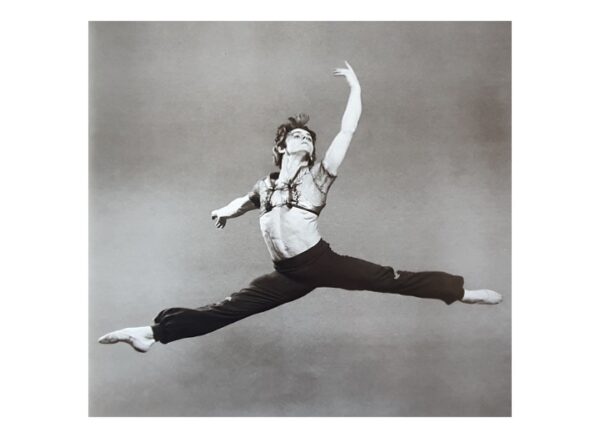
The most exquisitely chilling weapon in the arsenal of this complete dancer was his ballon, his ability to ascend in the air and stay there, defying gravity, especially in the double tour en l’air, in which the male dancer revolves two full times before landing.
The Stuttgart Ballet’s Richard Cragun can turn three times in a blur of motion. But Baryshnikov did it in slow motion. And it was unbelievable.
He blasted off with the hesitation and majesty of a spaceship. He turned – once, twice – and every thread on his costume was plainly visible as he soared high above the audience like an astronaut looking back at earth.
The authors describe a similar phenomenon happening in team sports. They quote Bill Russell, who played for the Boston Celtics, describing how the basketball team produced magic in games. Bill explains how the process would start with three or four of the team’s top players acting as a catalyst. He explained this in the following way.
“The feeling would spread to the other guys and we’d all levitate. At that special level all sorts of odd things happened. It was almost as if we were playing in slow motion.”
Bill goes on to describe what happened next.
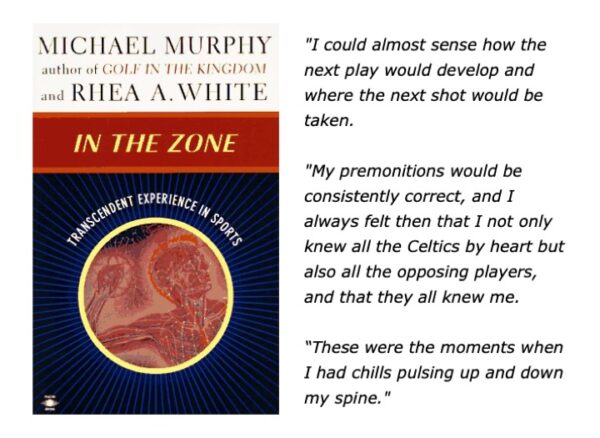
Some people experience this feeling in their daily lives. They do this by continuing to have a sense of gratitude, appreciate life or feel at one with the world. They may experience it when doing creative work, playing music or performing another activity.
Some people experience it through their senses. They immerse themselves in activities and feel fully alive. They then feel transported into another dimension.
Some people may also experience something like the original Greek definition of ecstasy. This involves standing outside oneself and becoming at one with the experience. Sometimes it involves being in a state of rapture or at one with the divine.
Some people experience this feeling through making a creative breakthrough. They may be deeply engaged in a piece of work or searching to find a solution. The moment of enlightenment then brings a rush of happiness. Carl Sagan said, for example:
“Understanding is a kind of ecstasy.”
Let’s return to your own life and work. Looking to the future, can you think of a situation where you may want to follow elements of the enjoyable work approach. How can you do this in your own way?
If you wish, try tackling the exercise on this theme. This invites you to complete the following sentences.
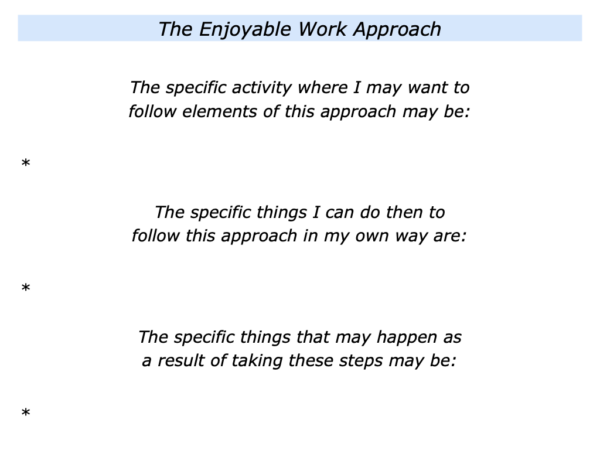






Leave a Reply